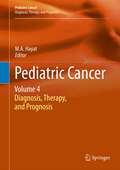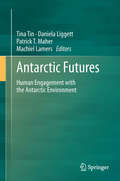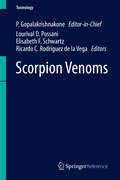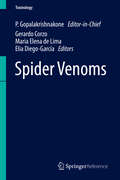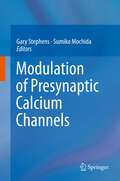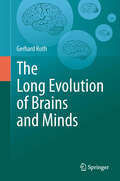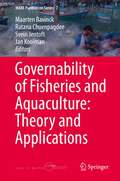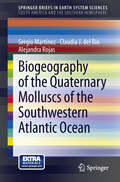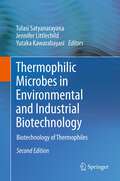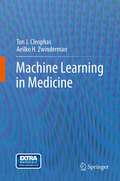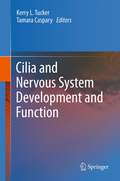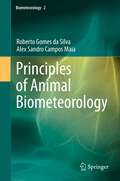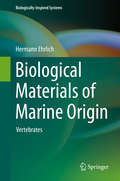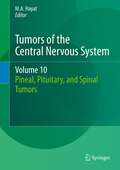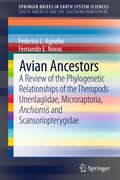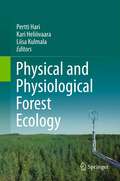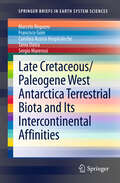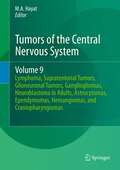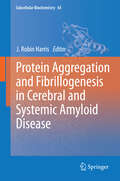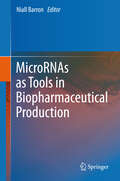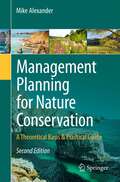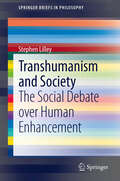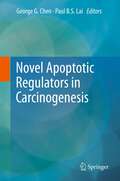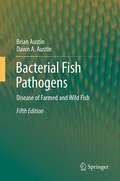- Table View
- List View
Pediatric Cancer, Volume 4: Diagnosis, Therapy, and Prognosis (Pediatric Cancer #4)
by M. A. HayatThis entry in the series Pediatric Cancer offers comprehensive information on a variety of cancers, concentrating on brain tumors, the most common solid tumors and the leading cause of cancer-related mortality in children. The contents are organized in seven sections: Neuroblastoma, Medulloblastoma, Leukemia, Lymphoma, Rhabdoid, Sarcoma and Miscellaneous Tumors. Coverage includes pediatric medulloblastoma, and treatments including craniospinal radiation followed by adjuvant chemotherapy. The contributors explain diagnosis and chemotherapy of children with acute lymphoblastic leukemia, and diagnosis of bone marrow involvement in pediatric lymphoma patients. Ewing’s sarcoma, a highly malignant connective tissue neoplasm formed by the proliferation of mesenchymal cells, receives extensive coverage, including targeting of molecular pathways and chemotherapy and surgical treatment. The roles of apoptotic genes, MYCN gene, MDM2, and SNP309, P13K inhibitors, alternative splicing and microRNAs, activated leukocyte cell adhesion molecule and inhibition by alu-like RNA in neuroblastoma are discussed in detail.The book explores the molecular genetics, diagnosis, prognosis and therapy of the atypical teratoid/rhabdoid tumor (AT/RT). Among the most common malignant neoplasms in children, AT/RT exhibits similarities with other CNS tumors, which can lead to misclassification, as pointed out in the book. The contributors discuss diagnosis of AT/RT type using imaging technology, and describe new strategies, including intensive multimodal therapy and high dose chemotherapy with autologous stem cell transplantation that have shown improved outcomes. Coverage of therapies includes total resection followed by aggressive chemotherapy and radiation. Discussion includes diagnosis and treatment of other pediatric tumors including adrenocortical tumors, supratentorial primitive neuroectodermal tumors, giant midline tumors, gastrointestinal stromal tumors, ependymomas and intramedullary cavernoma. Pediatric Cancer: Diagnosis, Therapy and Prognosis, Volume 4 includes contributions by ninety-one contributors - oncologists, neurosurgeons, physicians, research scientists and pathologists - representing thirteen countries. The editor, M.A. Hayat, is a Distinguished Professor in the Department of Biological Sciences at Kean University, Union, New Jersey, USA.
Antarctic Futures: Human Engagement with the Antarctic Environment
by Tina Tin Daniela Liggett Patrick T Maher Machiel LamersAt the beginning of the 21st century, Antarctica is poised at the edge of a warmer and busier world. Leading Antarctic researchers examine the needs and challenges of Antarctic environmental management today and tomorrow. Through: (i) investigating the impacts of human activities on specific ecosystems and species, (ii) examining existing environmental management and monitoring practices in place in various regions and (iii) interrogating stakeholders, they address the following questions: What future will Business-As-Usual bring to the Antarctic environment? Will a Business-As-Usual future be compatible with the objectives set out under the Antarctic Treaty, especially its Protocol on Environmental Protection? What actions are necessary to bring about alternative futures for the next 50 years? This volume is an outcome of the International Polar Year (2007-2009) Oslo Science Conference (8-12, June, 2010).
Scorpion Venoms (Toxinology Ser. #4)
by P. Gopalakrishnakone, Lourival D. Possani, Elisabeth F. Schwartz and Ricardo C. Rodríguez de la VegaSpider Venoms (Toxinology Ser. #3)
by P. Gopalakrishnakone, Gerardo A. Corzo, Maria Elena de Lima and Elia Diego-GarcíaModulation of Presynaptic Calcium Channels
by Gary Stephens and Sumiko MochidaThis book will bring together leading international experts to discuss recent advances in basic scientific knowledge regarding the regulation of presynaptic Ca2+ channels. Importantly, Ca2+ channels represent one of the most widely modulated proteins in the body, being the target of a range of effector pathways and drugs; this range will be fully represented here. A number of therapeutic drugs target the Ca2+ channel complex, including the anti-epileptic gabapentinoid and analgesic ziconotide drugs and the pharmaceutical industry is searching for Ca2+ channel blocking drugs, particularly in the pain, epilepsy, ataxia and migraine areas. Such potential future therapies will be discussed here. Scientific disciplines will focus on electrophysiological studies, but will extend to neuroscience, genetics and biochemical areas. The work described will represent advances at the cutting edge of current neuroscience research and is timely and highly appropriate for the Springer book series.
The Long Evolution of Brains and Minds
by Gerhard RothThe main topic of the book is a reconstruction of the evolution of nervous systems and brains as well as of mental-cognitive abilities, in short “intelligence” from simplest organisms to humans. It investigates to which extent the two are correlated. One central topic is the alleged uniqueness of the human brain and human intelligence and mind. It is discussed which neural features make certain animals and humans intelligent and creative: Is it absolute or relative brain size or the size of “intelligence centers” inside the brains, the number of nerve cells inside the brain in total or in such “intelligence centers” decisive for the degree of intelligence, of mind and eventually consciousness? And which are the driving forces behind these processes? Finally, it is asked what all this means for the classical problem of mind-brain relationship and for a naturalistic theory of mind.
Governability of Fisheries and Aquaculture: Theory and Applications (MARE Publication Series #7)
by Maarten Bavinck, Ratana Chuenpagdee, Svein Jentoft and Jan KooimanFollowing from Fish for Life – Interactive Governance for Fisheries (Kooiman et al., 2005), which presents an interdisciplinary and intersectoral approach to the governance of capture and aquaculture fisheries, this volume pursues what interactive governance theory and the governability perspective contribute to the resolution of key fisheries problems, these include overfishing, unemployment and poverty, food insecurity, and social injustice. Since these problems are varied and can be felt among governments, resource users and communities globally, the diagnosis must be holistic, and take account of principles, institutions, and operational conditions. The authors argue that ‘wicked problems’ and institutional limitations are inherent to each setting, and must be included in the analysis. The volume thereby offers a new lens and a systematic approach for analysing the nature of problems and challenges concerning the governance of fisheries, explores where these problems are situated, and how potential solutions may be found. ”It now seems clear that the crisis in the world’s fisheries [is] a much larger and more complex problem than many had imagined. Yet, examining it through the lens of governability may offer the best hope for alleviating it--as well as alleviating similar crises in other social systems.” James R. McGoodwin (Professor Emeritus, University of Colorado)
Biogeography of the Quaternary Molluscs of the Southwestern Atlantic Ocean (SpringerBriefs in Earth System Sciences)
by Sergio Martínez Claudia J. del Río Alejandra RojasThe Quaternary comprises a brief time in the Earth’s history, and apart from a few exceptions, molluscan assemblages recovered from exposures along the coast of Southwestern South America (Southern Brazil, Uruguay, Argentina) are essentially the same than those that inhabit the region today, leading to the assumption that no important change in the distribution of the faunas since Pleistocene times has occurred. However, the good taxonomic and temporal resolution reached in the last years, allowed us to detect some biogeographic changes, although traditional biogeographic units remain the same (i.e. Magellanic and Argentinean Provinces). These modifications involve mainly variations in the taxonomic composition of the assemblages and in the southern boundaries of some species distributions (extralimital species), today retracted northwards. These changes are related to southward shifts of the warm waters of the Brazilian Current, correlated with global warm peaks. This phenomenon was more intense in the Late Pleistocene (MIS 5e) and in the Holocene between ca. 6500-3500 14C yr.
Thermophilic Microbes in Environmental and Industrial Biotechnology: Biotechnology of Thermophiles
by Tulasi Satyanarayana, Jennifer Littlechild and Yutaka KawarabayasiThe existence of life at high temperatures is quiet fascinating. At elevated temperatures, only microorganisms are capable of growth and survival. Many thermophilic microbial genera have been isolated from man-made (washing machines, factory effluents, waste streams and acid mine effluents) and natural (volcanic areas, geothermal areas, terrestrial hot springs, submarine hydrothermal vents, geothermally heated oil reserves and oil wells, sun-heated litter and soils/sediments) thermal habitats throughout the world. Both culture-dependent and culture-independent approaches have been employed for understanding the diversity of microbes in hot environments. Interest in their diversity, ecology, and physiology has increased enormously during the past few decades as indicated by the deliberations in international conferences on extremophiles and thermophiles held every alternate year and papers published in journals such as Extremophiles. Thermophilic moulds and bacteria have been extensively studied in plant biomass bioconversion processes as sources of industrial enzymes and as gene donors. In the development of third generation biofuels such as bioethanol, thermophilic fungal and bacterial enzymes are of particular interest. The book is aimed at bringing together scattered up-to-date information on various aspects of thermophiles such as the diversity of thermophiles and viruses of thermophiles, their potential roles in pollution control and bioremediation, and composting.
Machine Learning in Medicine
by Ton J. Cleophas Aeilko H. ZwindermanMachine learning is a novel discipline concerned with the analysis of large and multiple variables data. It involves computationally intensive methods, like factor analysis, cluster analysis, and discriminant analysis. It is currently mainly the domain of computer scientists, and is already commonly used in social sciences, marketing research, operational research and applied sciences. It is virtually unused in clinical research. This is probably due to the traditional belief of clinicians in clinical trials where multiple variables are equally balanced by the randomization process and are not further taken into account. In contrast, modern computer data files often involve hundreds of variables like genes and other laboratory values, and computationally intensive methods are required. This book was written as a hand-hold presentation accessible to clinicians, and as a must-read publication for those new to the methods.
Cilia and Nervous System Development and Function
by Kerry L. Tucker and Tamara CasparyCilia are tiny microtubule-based organelles projecting from the plasma membrane of practically all cells in the body. In the past 10 years a flurry of research has indicated a crucial role of this long-neglected organelle in the development and function of the central nervous system. A common theme of these studies is the critical dependency of signal transduction of the Sonic hedgehog, and more recently, Wnt signaling pathways upon cilia to regulate fate decisions and morphogenesis. Both primary and motile cilia also play crucial roles in the function of the nervous system, including the primary processing of sensory information, the control of body mass, and higher functions such as behavior and cognition, serving as "antennae" for neurons to sense and process their environment. In this book we describe the structure and function of cilia and the various tissues throughout the brain and spinal cord that are dependent upon cilia for their proper development and function.
Virginia Woolf and Neuropsychiatry
by Maxwell BennettThis book, written by one of the leaders in the field of the neurosciences, will give an explanation of the symptoms and eventual untimely suicide of one of literatures greatest authors; Virginia Woolf. The sources used are letters and statements from Woolf herself, the literature she wrote and comments, letters and any other documentation that referred to her mental state and her medical status. The author will use current insight into depression, the mental consequences of child abuse and drug interactions/effects to illustrate this case study. The book should appeal to researchers in the neurosciences, psychology and psychiatry as well as to a broader audience, mainly individuals who are interested in the (external and internal) forces that drove Woolf to write her material.
Principles of Animal Biometeorology (Biometeorology #2)
by Roberto Gomes da Silva Alex Sandro Campos MaiaThe book begins by describing in detail the mechanisms of energy exchange – radiative, convective, conductive and evaporative – together with techniques for their determination. The discussion extends to the importance of CO2, ozone and methane, together with that of aerosol pollutants and the evolution of atmospheric CO2. Subsequent chapters apply the results of the biophysical methods to mammals, birds and aquatic animals. Discussion includes problems of shelter and shade for animals in tropical environments and techniques for the thermal evaluation for shelters and for several tree types. The details of heat exchange between animals and the environment are presented, in separate chapters covering Mammals and Birds and Aquatic Mammals. A chapter on Shade and Shelter describes the importance of shade for animals, factors of shade efficiency, the protections offered by shelter and methods of calculating the protection afforded by both shade and shelter. A Special Methods chapter offers a variety of techniques for evaluating cutaneous and respiratory evaporation, and practical methods for sampling of hairs and the evaluation of hair coat characteristics.
Biological Materials of Marine Origin: Vertebrates (Biologically-Inspired Systems #4)
by Hermann EhrlichThis is the second monograph by the author on biological materials of marine origin. The initial book is dedicated to the biological materials of marine invertebrates. This work is a source of modern knowledge on biomineralization, biomimetics and materials science with respect to marine vertebrates. For the first time in scientific literature the author gives the most coherent analysis of the nature, origin and evolution of biocomposites and biopolymers isolated from and observed in the broad variety of marine vertebrate organisms (fish, reptilian, birds and mammals) and within their unique hierarchically organized structural formations. There is a wealth of new and newly synthesized information, including dozens of previously unpublished images of unique marine creatures including extinct, extant and living taxa and their biocomposite-based structures from nano- to micro – and macroscale. This monograph reviews the most relevant advances in the marine biological materials research field, pointing out several approaches being introduced and explored by distinct modern laboratories.
Tumors of the Central Nervous System, Volume 10: Pineal, Pituitary, and Spinal Tumors (Tumors of the Central Nervous System #10)
by M. A. HayatAdding to a vitally important cycle of publications covering the latest research developments in our understanding of neoplasms affecting the human central nervous system, this edition focuses on numerous aspects of pineal, pituitary, and spinal tumors. As with the previous volumes in the series, this latest work addresses a central imperative in cancer research—the need to standardize classifications, written definitions and investigative guidelines in order to achieve a measure of shared objectivity among academics engaged in one of the most important medical endeavors of our era. It brings together the very latest work by oncologists, neurosurgeons, physicians, research scientists, and pathologists, providing the medical community with a wealth of data and results that, taken together, will advance the cause of cancer research. The volume synthesizes work on diagnosis, drug development, and therapeutic approaches that are typically scattered in a variety of journals and books. It features promising recent work in applying molecular genetics to clinical practice and evidence-based therapy, covering molecular profiling of tumors as well as a number of surgical treatments such as resection and radiosurgery. Together with its counterpart publications, it represents a much-needed central resource that will inform and guide future research efforts.
Avian Ancestors: A Review of the Phylogenetic Relationships of the Theropods Unenlagiidae, Microraptoria, Anchiornis and Scansoriopterygidae (SpringerBriefs in Earth System Sciences)
by Federico Agnolin Fernando E. NovasAlthough consensus exists among researchers that birds evolved from coelurosaurian theropods, paleontologists still debate the identification of the group of coelurosaurians that most closely approaches the common ancestor of birds. The last 20 years witnessed the discovery of a wide array of avian-like theropods that has considerably amplified the anatomical disparity among deinonychosaurians, some of which resemble Archaeopteryx more than Deinonychus. Among these newly discovered theropods that show remarkable bird-like characteristics are the four-winged theropods Microraptor and Anchiornis, and the unenlagiids Unenlagia, Buitreraptor, and Rahonavis. A bizarre group of minute-sized coelurosaurs, the Scansoriopterygidae, also exhibits some avian similarities that lead some authors to interpret them as more closely related to birds than other dinosaurs. With the aim to explore the phylogenetic relationships of these coelurosaurians and birds, we merged recently published integrative databases, resulting in significant changes in the topological distribution of taxa within Paraves. We present evidence that Dromaeosauridae, Microraptoria, Unenlagiidae, and Anchiornis + Xiaotingia form successive sister taxa of Aves, and that the Scansoriopterygidae are basal coelurosaurians not closely related to birds. The implications in the evolutionary sequence of anatomical characters leading to birds, including the origin of flight, are also considered in light of this new phylogenetic hypothesis.
Physical and Physiological Forest Ecology
by Pertti Hari, Kari Heliövaara and Liisa KulmalaThis book introduces a holistic synthesis of carbon and nitrogen fluxes in forest ecosystems from cell to stand level during the lifetime of trees. Establishing that metabolism and physical phenomena give rise to concentration, pressure and temperature differences that generate the material and energy fluxes between living organisms and their environment. The editors and authors utilize physiological, physical and anatomical background information to formulate theoretical ideas dealing with the effects of the environment and the state of enzymes, membrane pumps and pigments on metabolism. The emergent properties play an important role in the transitions from detailed to more aggregate levels in the ecosystem. Conservation of mass and energy allow the construction of dynamic models of carbon and nitrogen fluxes and pools at various levels in the hierarchy of forest ecosystems.
Late Cretaceous/Paleogene West Antarctica Terrestrial Biota and its Intercontinental Affinities (SpringerBriefs in Earth System Sciences)
by Marcelo Reguero Francisco Goin Carolina Acosta Hospitaleche Tania Dutra Sergio MarenssiOne of the most intriguing paleobiogeographical phenomena involving the origins and gradual sundering of Gondwana concerns the close similarities and, in most cases, inferred sister-group relationships of a number of terrestrial and freshwater vertebrate taxa, e.g., dinosaurs, flying birds, mammals, etc., recovered from uppermost Cretaceous/ Paleogene deposits of West Antarctica, South America, and NewZealand/Australia. For some twenty five extensive and productive investigations in the field of vertebrate paleontology has been carried out in latest Cretaceous and Paleogene deposits in the James Ross Basin, northeast of the Antarctic Peninsula (AP), West Antarctica, on the exposed sequences on James Ross, Vega, Seymour (=Marambio) and Snow Hill islands respectively. The available geological, geophysical and marine faunistic evidence indicates that the peninsular (AP) part of West Antarctica and the western part of the tip of South America (Magallanic Region, southern Chile) were positioned very close in the latest Cretaceous and early Paleogene favoring the “Overlapping” model of South America-Antarctic Peninsula paleogeographic reconstruction. Late Cretaceous deposits from Vega, James Ross, Seymour and Snow Hill islands have produced a discrete number of dinosaur taxa and a number of advanced birds together with four mosasaur and three plesiosaur taxa, and a few shark and teleostean taxa.
Tumors of the Central Nervous System, Volume 9: Lymphoma, Supratentorial Tumors, Glioneuronal Tumors, Gangliogliomas, Neuroblastoma in Adults, Astrocytomas, Ependymomas, Hemangiomas, and Craniopharyngiomas (Tumors of the Central Nervous System #9)
by M. A. HayatThe ninth volume in this essential series discusses key advances in our understanding of neoplasms in the human central nervous system. This publication deals with various aspects of nine separate types of brain tumors. With 70 contributors from 17 nations, this edition offers an unrivalled thoroughness and breadth of coverage that includes the very latest research results on the following tumor types: astrocytoma, lymphoma, supratentorial and glioneuronal tumors, gangliogliomas, neuroblastoma in adults, hemangioma, and ependymoma. The content introduces new technologies and their applications in diagnosis, treatment and therapy of tumors. It explains molecular profiling techniques that enable oncologists to select appropriate therapies for clinical trials, and discusses a number of surgical treatments, including resection and radiosurgery. Volume 9 is interspersed with color illustrations and tables depicting many of the results. This volume joins its fellow publications in a valuable series that fully explores controversies and debates in CNS cancer therapy, and furthers the scientific quest for effective therapies to combat cancer in all its forms.
Protein Aggregation and Fibrillogenesis in Cerebral and Systemic Amyloid Disease (Subcellular Biochemistry #65)
by J. Robin HarrisThis volume of the Subcellular Biochemistry series is the result of the long-standing research interest of the editor in the molecular mechanism underlying Alzheimer’s disease and other amyloid diseases, indicated also by the earlier book in the series (Volume 38), devoted to Alzheimer’s disease. The broad coverage within the present amyloidogenesis book represents an attempt to collate current knowledge relating to the proteins and peptides involved in most of the known amyloid diseases, together with some amyloid/fibril-forming proteins and peptides that are not involved in diseases. Thus, the range of topics included is comprehensive and furthermore it was thought appropriate to include both basic science and clinical presentation of the subjects under discussion.
MicroRNAs as Tools in Biopharmaceutical Production
by Niall BarronFocused manuscript on the potential use/role of miRNAs in bioprocessing, specifically the production of complex proteins in mammalian cells. With that in mind I propose a draft list of topics/chapters along the following lines: Intro on CHO/bioprocessing/engineering challenges to set scene, Genomic organization, biogenesis and mode of action, Identifying miRNA targets: Computational prediction, transcriptomics, proteomices, UTR analysis, etc., miRNA expression in Chinese Hamster Ovary cells, miRNAs as engineering targets: pathway manipulation to impact bioprocess phenotypes, miRNAs as biomarkers, Detection methods: Northern, PCR, hybridization arrays, Next Gen Seq, Manipulation of expression in cultured cells: Transient/stable disregulation, Knockout.
Management Planning for Nature Conservation: A Theoretical Basis & Practical Guide
by Mike AlexanderThe first edition of Mike Alexander’s Management Planning for Nature Conservation, brought a new dimension to the modern literature on conservation management. This second edition, a significant enhancement of the original, deals with the development both, conceptual and practical, of adaptive management planning for nature conservation. It is about preparing management plans, and guides the reader through the entire process. Case-studies, including a conservation and access plan, demonstrate the planning process in action. This approach to planning can be applied to any place which is managed entirely, or in part, for wildlife. It can be applied to the management of species or habitats in any circumstance, regardless of site designation. The process is fully compatible with the Convention on Biological Diversity’s ‘ecosystem approach’ to conservation management.Mike Alexander has long been at the forefront of developing management planning for conservation, with experience ranging from Uganda to Estonia, and from Costa Rica to Wales. He is the General Secretary of the Conservation Management System Consortium, a group of organisations with a common aim of raising standards and developing best practice in conservation management and planning. In 2012 Mike Alexander was elected a Fellow of the Society of Biology in recognition of his contribution to nature conservation and in particular management planning.This book has drawn on the experiences and expertise of the CMS consortium and other leaders in both conservation research and wildlife management from around the world. It is essential reading for professional conservation managers and any student studying management planning for conservation within a range of degree and postgraduate courses.
Transhumanism and Society: The Social Debate over Human Enhancement (SpringerBriefs in Philosophy)
by Stephen LilleyThis book provides an introductory overview to the social debate over enhancement technologies with an overview of the transhumanists' call to bypass human nature and conservationists' argument in defense of it. The author present this controversy as it unfolds in the contest between transhumanists proponents and conservationists, who push back with an argument to conserve human nature and to ban enhancement technologies. This book provides an overview of the key contested points and present the debate in an orderly, constructive fashion. Readers are informed about the discussion over humanism, the tension between science and religion, and the interpretation of socio-technological revolutions; and are invited to make up their own mind about one of the most challenging topics concerning the social and ethical implications of technological advancements.
Novel Apoptotic Regulators in Carcinogenesis
by George G. Chen and Paul B. S. LaiOur recent understanding of the cellular and molecular defects and the regulation of the apoptotic signalling pathways has resulted in rationally designed anticancer strategies and the development of novel agents that regulates apoptosis. A comprehensive review of all apoptotic-related anticancer therapies is not the purpose of this book. However, in the volume of this book with 11 chapters, we have described a number of novel apoptotic regulators that have shown promising value and also great feasibility for cancer treatment. These novel agents either occur naturally or are chemically synthesized. While we are excited about the discovery and development of these novel apoptotic regulators as potential anticancer agents, a degree of caution should be always borne in mind when interpreting the success of preclinical pro-apoptotic candidates since potential problems inevitably lie ahead. These problems usually include target specificity, unanticipated toxicity, compound stability, formulation issues, pharmacokinetic and pharmacodynamic profiles. Nevertheless, we believe that this collection of 11 chapters by established leaders in the area of apoptosis will be of great interest to not only academics working in the field of cancer research and apoptosis but also pharmaceutical and pharmacological industries that . We are looking forward to the further development to push these potential agents toward clinical stage.
Bacterial Fish Pathogens: Disease of Farmed and Wild Fish
by Brian Austin Dawn A. AustinThis completely updated fifth edition of Bacterial Fish Pathogens is a comprehensive discussion of the biological aspects of the bacteria which cause disease in farmed and wild fish. Since the 4th edition was published in 2007, there has been an upturn in the application of molecular approaches to taxonomy, diagnosis and vaccine development. New pathogens, e.g. Aeromonas schubertii, have been described. Also, there has been the emergence of diseases caused by bacteria which have not been cultured, and which have been equated with new taxa, i.e. ‘Candidatus’. Consideration is given to all the bacterial fish pathogens, including primary pathogens and opportunists.
